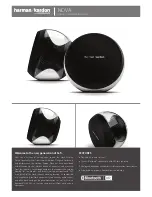
DSP
EAKER
S
ERVO
300
2.5 ASCM Calibration
The speakers are incorporated with patent pending processor controlled
Position Feedback
measurement
and
Active Suspension Compliance Management System, ASCM
. Thanks to
the ASCM, the speaker will not suffer any common phenomena of uncontrolled low
frequency energy storages, and will deliver the fastest, tightest and most accurate bass
possible even to the lowest octaves inroom. The speaker has also not herited the “boxy” or
“boomy” sound character of reflextype speakers, as the active suspension with closed
enclosure will offer unmatched control over the entire audible bass range.
The ASCM is calibrated at the factory, which will be sufficient for years to come. However, as
in all speaker drivers, the spring compliance of the cone will vary after extensive usage over
the years. To compensate for this, it is adviceable to run ASCM calibration once the speaker
has been used for about one or two years (depending on activity). Later on, the parameters
do not vary any more, meaning ASCM doesn't necessarily need to be calibrated again.
ASCM calibration will measure how much the suspension compliance has been altered since
the original values, and automatically compensate for these. The settings are stored in the
internal memory of Servo 300, where they will remain until another ASCM calibration
overwrites them.
Before calibration, the output gain must be at 0dB, or the calibration will not begin.
The ASCM calibration is performed quite like the AntiMode calibration, except the
microphone is not connected to its jack. To perform ASCM calibration, simply press and hold
the control button. The calibration will make one sweep, but after it detects that there is no
microphone connected, it will continue with different kind of test signals (subsonic high
excursion excitation). The ASCM calibration will also feature restarting of the speaker, and
remeasuring the rest position of the cone springs.
It is extremely important not to touch
the speaker cone even if it there is no sound nor movement during the ASCM
calibration!
The ASCM calibration is finished once the speaker will return to it's normal
operation state (led is green if AntiMode was engaged and orange if it was bypassed).
Note: The ASCM calibration does not affect on the room corrections being applied after Anti
Mode calibration.
Rev. 1.6
21.06.2010
Page 12 (16)


































